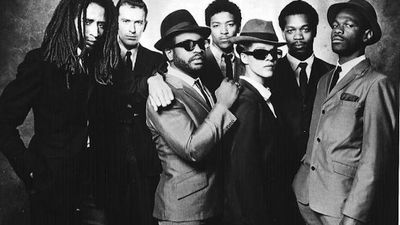'Return Of The Rudeboy' At London's Somerset House
Take a look at images from Dean Chalkley's photo exhibition 'Return Of The Rudeboy' on display at London's Somerset House.
What is rude? According to Dean Chalkley, photographer of the new Return of the Rudeboy exhibition at London’s Somerset House, being a rudeboy or girl is “not actually about elements of how you dress. It’s more an attitude.” The presentation, curated by Chalkley and creative director Harris Elliott, showcases photos of people that embody rudeboy style in the 21st century. Also on display are carefully selected pieces of clothing and accessories reflecting the rudeboy's sartorial attention to detail. Other quirky details, including a stepper bicycle custom designed for the show and a barber shop, provide a glimpse into the organisers’ understanding of the culture.
The term rudeboy originated in late 1950s Jamaica to designate rebellious youth who styled themselves after American jazz and R&B musicians of the period. Elements of their dress included sharp suits and trilby or pork pie hats, and they were closely associated with ska and rocksteady music. Often employed by sound system operators to protect their events or disrupt those of their rivals, rudeboys were initially viewed as violent and rowdy. This image changed somewhat when Jamaican immigrants brought rudeboy style and music to the UK in the 1960s, triggering its rise in popularity amongst young mods. As Chalkley explains: “There was this DJ called Count Suckle, who was a legendary chap because what he did was, he DJed in a club called the Roaring Twenties on Carnaby Street and was playing ska. And what happened was the young mods, the young white, working class kids, would go down to the club and other cubs in London as well, like the Flamingo, and that was the first time they’d heard ska music and they’d be like ‘what’s this?’ and they’d see Pork Pie hats and be ‘ok.’ So the sartorial nature of it crossed over, but also musically it crossed over as well.”
Since then rudeboy culture has experienced various waves of popularity, particularly during the ska revival of the late 1970s, led by 2 Tone bands like The Specials and The Selecter. However according to Elliott, the latest incarnation of rudeboy style, celebrated in this exhibition, is different from previous ones: “Now music isn’t the binding thing, the glue between all these people. Right now my perception is that some people have not stopped being rudeboys, and there are new people who’ve come into it. But I think people need a bit of a voice and need a bit of an identity. There aren’t so many style tribes anymore, these definitions aren’t there and I think people are looking for new forms of identity. And the aesthetic of rudeboy as a mindset and a lifestyle is very important as people actually want to be part of something.”
Another distinguishing element of contemporary rudeboy style is its global appeal. The exhibition features models of different ages, genders and walks of life, including Angolan designer and tailor Sam Lambert of Art Comes First, who says rudeboy culture has long had an influence on African style: “I believe we were all rudeboys since back home but we really never named it or saw it that way. But I remember my uncles and big brothers used to act and dress like rudeboys. Right now in Africa The Sartists, The Smarteez and I See a Different You are back home rudies. As well as Loux the Vintage Guru in Namibia.” In terms of what’s behind the global appeal of rudeboy culture he thinks it’s because “everybody is welcome to be part of it, because in some ways we all contribute to it by being nomads. Style is only relevant if it travels and other people see it and become familiar with it.”
When questioned about the global appeal of rudeboy culture, Chalkley explains: “You’ll see from all these photographs there’s actually a wide gamut of what people are wearing. So it’s not like you have to wear a particular thing, it’s more that the way these people are wearing what they wear conveys an attitude. And the confidence with which it’s worn also displays that same characteristic, so there’s a conscious decision of what’s been put together. It’s not about being rich, it’s just about putting things together in a certain way and having the confidence to do it.” Harris adds: “There’s no identikit way of wearing it, it’s about a mindset. It’s an attitude, it’s not about being male or female or black or white, it’s an identity thing.”
Return of the Rudeboy is on display at the Somerset House in London from 13th June to 25th August
>>>HEAD OVER TO LARGE UP FOR MORE PHOTOS & HIGHLIGHTS FROM 'RETURN OF THE RUDEBOY'
